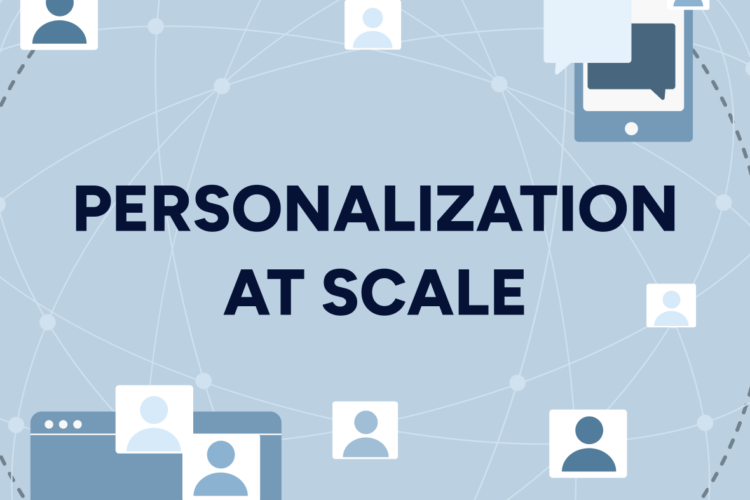
I. Introduction to Personalization at Scale
II. Benefits of Personalization at Scale
III. Challenges of Implementing Personalization at Scale
IV. Strategies for Successful Personalization at Scale
Personalization at scale is a game-changer in today’s fast-paced digital world. It’s all about tailoring content, products, and experiences to meet the unique needs and preferences of individual customers. Gone are the days of generic marketing messages that speak to the masses. With personalization at scale, businesses can create a more personalized and engaging experience for their customers, leading to increased customer satisfaction and loyalty.
So, what exactly is personalization at scale, you ask? Well, it’s the ability to deliver personalized content or recommendations to a large number of customers in real time. This means using data and technology to analyze customer behavior, preferences, and demographics, and then using that information to deliver targeted messages and offers. Whether it’s recommending products based on past purchases, sending tailored emails based on browsing history, or customizing a website based on location, personalization at scale is all about creating a more relevant and personalized experience for each and every customer.
Now, you might be wondering, what are the benefits of personalization at scale? Let me tell you, there are plenty! For starters, personalization can lead to increased customer engagement and loyalty. By delivering content and offers that are tailored to each customer’s individual needs and interests, businesses can create a deeper connection with their audience. This can result in higher conversion rates, increased sales, and ultimately, more loyal customers who keep coming back for more.
But it’s not just about making customers happy – personalization at scale can also have a positive impact on a business’s bottom line. By delivering targeted messages and offers to the right customers at the right time, businesses can increase their ROI and drive revenue growth. In fact, studies have shown that personalized messages can drive up to 20% more sales than generic messages. And who doesn’t want to see their sales numbers go up?
Of course, implementing personalization at scale isn’t without its challenges. From collecting and analyzing data to creating personalized content and campaigns, there’s a lot that goes into making personalization work on a large scale. But fear not, dear reader, for there are strategies and best practices that can help businesses overcome these challenges and succeed in their personalization efforts. Stay tuned for the next installment, where we’ll delve into the benefits of personalization at scale in more detail. Until then, happy personalizing!
Benefits of Personalization at Scale
Welcome, dear reader! Today, we are going to delve into the wonderful world of personalization at scale. Imagine a world where every interaction with a brand feels tailor-made just for you. Sounds pretty amazing, right? Well, that’s the power of personalization at scale!
But what exactly are the benefits of implementing personalization at scale? Let’s break it down for you:
- Improved Customer Experience: Personalization at scale allows brands to create unique and relevant experiences for each customer. By tailoring content, product recommendations, and promotions to individual preferences, brands can enhance the overall customer experience and build stronger relationships with their audience.
- Increased Customer Engagement: When customers feel like a brand truly understands their needs and preferences, they are more likely to engage with the brand’s content, products, and services. Personalization at scale can lead to higher click-through rates, longer time spent on site, and increased conversions.
- Enhanced Brand Loyalty: By delivering personalized experiences, brands can strengthen customer loyalty and encourage repeat purchases. When customers feel valued and understood, they are more likely to become brand advocates and recommend the brand to others.
- Higher Revenue and ROI: Personalization at scale has been shown to drive significant increases in revenue and return on investment. By delivering personalized experiences that resonate with customers, brands can increase sales, improve customer retention, and ultimately, boost their bottom line.
- Competitive Advantage: In today’s crowded marketplace, personalization at scale can give brands a competitive edge. By standing out from the competition and offering a more personalized experience, brands can attract and retain customers more effectively, ultimately gaining a larger share of the market.
As you can see, the benefits of personalization at scale are truly remarkable. By leveraging data and technology to deliver personalized experiences, brands can create deeper connections with their customers, drive engagement and loyalty, and ultimately, achieve greater success in the marketplace. So, if you haven’t already started exploring personalization at scale for your brand, now is the perfect time to start!
Challenges of Implementing Personalization at Scale
Implementing personalization at scale can be a daunting task for many businesses. While the benefits are clear, there are several challenges that organizations may face when trying to personalize their customer experiences on a large scale. Let’s explore some of the common challenges and how to overcome them:
1. Data Management and Integration
One of the biggest challenges of implementing personalization at scale is managing and integrating data from various sources. With data coming in from multiple touchpoints such as websites, social media, CRM systems, and more, it can be overwhelming to consolidate and make sense of all this information. To tackle this challenge, it is essential to invest in robust data management systems and tools that can help you centralize and analyze data effectively.
2. Resource Constraints
Another common challenge is resource constraints, both in terms of budget and manpower. Implementing personalization at scale requires investment in technology, talent, and ongoing optimization. Many organizations struggle with limited resources and may find it difficult to allocate enough budget and staff to drive personalization initiatives. To address this challenge, it is important to prioritize personalization efforts based on ROI and focus on initiatives that are most likely to drive results.
3. Technology Stack Complexity
With the proliferation of marketing technology solutions, organizations often find themselves grappling with a complex technology stack. Different tools and platforms may not always integrate seamlessly, leading to inefficiencies in data management and personalization efforts. To overcome this challenge, it is crucial to carefully evaluate and select technology vendors that offer interoperability and easy integration with other systems.
4. Privacy and Compliance Concerns
As personalization involves collecting and analyzing customer data, privacy and compliance concerns have become a major challenge for businesses. With regulations such as GDPR and CCPA in place, it is crucial to ensure that personalization efforts are conducted in a privacy-conscious manner and adhere to data protection laws. To address this challenge, organizations should adopt transparent data practices and obtain explicit consent from customers before implementing personalized experiences.
5. Content Creation and Optimization
Creating and optimizing personalized content at scale can be a significant challenge for businesses. Tailoring content to individual preferences and behaviors requires a deep understanding of your audience and the ability to create relevant, engaging experiences. To tackle this challenge, it is important to invest in content personalization tools and strategies that enable you to deliver the right message to the right audience at the right time.
By addressing these common challenges and implementing best practices, organizations can successfully scale their personalization efforts and deliver exceptional customer experiences.
“`html
Challenges of Implementing Personalization at Scale
Implementing personalization at scale can be a daunting task for many businesses. While the benefits are clear, there are several challenges that organizations may face when trying to personalize their customer experiences on a large scale. Let’s explore some of the common challenges and how to overcome them:
1. Data Management and Integration
One of the biggest challenges of implementing personalization at scale is managing and integrating data from various sources. With data coming in from multiple touchpoints such as websites, social media, CRM systems, and more, it can be overwhelming to consolidate and make sense of all this information. To tackle this challenge, it is essential to invest in robust data management systems and tools that can help you centralize and analyze data effectively.
2. Resource Constraints
Another common challenge is resource constraints, both in terms of budget and manpower. Implementing personalization at scale requires investment in technology, talent, and ongoing optimization. Many organizations struggle with limited resources and may find it difficult to allocate enough budget and staff to drive personalization initiatives. To address this challenge, it is important to prioritize personalization efforts based on ROI and focus on initiatives that are most likely to drive results.
3. Technology Stack Complexity
With the proliferation of marketing technology solutions, organizations often find themselves grappling with a complex technology stack. Different tools and platforms may not always integrate seamlessly, leading to inefficiencies in data management and personalization efforts. To overcome this challenge, it is crucial to carefully evaluate and select technology vendors that offer interoperability and easy integration with other systems.
4. Privacy and Compliance Concerns
As personalization involves collecting and analyzing customer data, privacy and compliance concerns have become a major challenge for businesses. With regulations such as GDPR and CCPA in place, it is crucial to ensure that personalization efforts are conducted in a privacy-conscious manner and adhere to data protection laws. To address this challenge, organizations should adopt transparent data practices and obtain explicit consent from customers before implementing personalized experiences.
5. Content Creation and Optimization
Creating and optimizing personalized content at scale can be a significant challenge for businesses. Tailoring content to individual preferences and behaviors requires a deep understanding of your audience and the ability to create relevant, engaging experiences. To tackle this challenge, it is important to invest in content personalization tools and strategies that enable you to deliver the right message to the right audience at the right time.
By addressing these common challenges and implementing best practices, organizations can successfully scale their personalization efforts and deliver exceptional customer experiences.
“`
Personalization at Scale is a powerful tool for businesses looking to connect with their customers on a deeper level. However, implementing personalization at scale can be a daunting task. From analyzing data to creating tailored experiences, there are many challenges to overcome. But fear not! I’m here to provide you with some strategies for successful personalization at scale that will help you navigate this complex landscape and achieve your goals.
### Strategies for Successful Personalization at Scale
**1. Leverage Data Analytics:** The key to successful personalization at scale lies in data analytics. By leveraging advanced analytics tools, you can gain valuable insights into customer behavior, preferences, and trends. This data can then be used to create personalized experiences that resonate with your target audience. Remember, data is king when it comes to personalization!
**2. Segment Your Audience:** One-size-fits-all approaches simply don’t cut it in today’s competitive market. To effectively personalize at scale, you need to segment your audience based on factors such as demographics, behavior, and preferences. This allows you to tailor your messaging and offerings to different groups, increasing the likelihood of engagement and conversion.
**3. Embrace Automation:** Implementing personalization at scale can be time-consuming and resource-intensive. That’s where automation comes in. By leveraging marketing automation tools, you can streamline the personalization process, delivering targeted messages to your audience at the right time and through the right channel. This not only saves you time but also ensures consistency and efficiency in your personalization efforts.
**4. Test and Iterate:** Personalization is not a one-time effort; it’s an ongoing process that requires constant monitoring and optimization. To ensure success, it’s important to test different personalization strategies and iterate based on the results. A/B testing, for example, can help you determine which personalization tactics are most effective and refine your approach accordingly.
**5. Focus on Customer Experience:** At the end of the day, personalization at scale is all about enhancing the customer experience. Make sure your personalized experiences are valuable, relevant, and engaging for your audience. Put yourself in your customers’ shoes and think about what they would want and expect from your brand. By prioritizing the customer experience, you can build stronger relationships with your audience and drive loyalty and advocacy.
In conclusion, personalization at scale is a powerful tool that can help you stand out in a crowded marketplace. By leveraging data analytics, segmenting your audience, embracing automation, testing and iterating, and focusing on the customer experience, you can successfully implement personalization at scale and drive meaningful results for your business. Remember, personalization is not a one-size-fits-all approach; it’s about creating tailored experiences that resonate with your audience. So go ahead, take the plunge, and start personalizing at scale today!










Comments